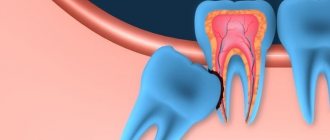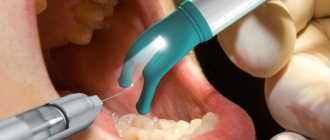The organic and inorganic tissues that make up the tooth form a close relationship. Hard tissues (tooth cement, dentin, enamel) belong to the inorganic part, but the pulp is a living, organic connective tissue, with the help of which the tooth is “nourished” from the inside. It is a bundle of nerves and blood vessels and is located in the pulp chamber of the tooth. Preserving the viability of the organic component is very important, because its death due to injury and infection leads to the appearance of a “dead tooth” in the oral cavity.
What is a “dead” tooth?
This is what dentists call a tooth without nerve endings that no longer receives blood. Consequently, the tooth stops receiving nutrients and its work stops, the tooth dies. The disruption of blood supply is explained by damage to the pulp, the area where blood vessels and nerve endings gather into a single bundle. If the vessels and nerves do not function, then the nutrients no longer support the life of the tooth.
What are the causes of “dead teeth”?
The pulp dies due to traumatic or infectious exposure. Injuries, bruises, and blows lead to tissue tearing and nerve death. Under the influence of external force, the coronal part breaks off, protecting the vascular bundle from damage. Due to a violation of integrity, bacteria enter the pulp chamber, causing the development of pulpitis and the death of nerves.
Impact of infection:
Poor oral hygiene provokes the development of caries. Deep caries without timely treatment leads to pulpitis. With pulpitis, the nerve endings become inflamed both in the pulp itself and in the root canals. Then the inflammation spreads to the ligamentous tissue located around the roots of the tooth - the periodontium, which helps keep the tooth in the socket. Infected periodontium (periodontitis) does not hold the tooth well in the bone bed and, when destroyed, often leads to the development of bone tissue destruction (cyst). Both the cyst and periodontitis itself in 90% of cases lead to tooth extraction.
Is it possible to cure such a tooth?
You can cure, but you cannot resurrect. The dentist will remove all affected tissues, nerves, root canals, expand them, clean them and treat them with an antiseptic, and then seal them hermetically so that infection does not enter from outside. The crown, if more than half of it is preserved, will be restored with a filling. For more severe lesions, an artificial crown will be installed. However, in case of extensive inflammation, the tooth can be removed and replaced with a prosthesis - an implant.
A “dead” tooth must be shown to a doctor, otherwise there is a risk of complications from the infection, which will develop into gumboil, osteomyelitis. A cured tooth can perform its function fully, but it can withstand the load worse, so its service life is significantly lower than that of “living” teeth.
Treatment
It is important a dying or dead tooth promptly . This is because left untreated, bacteria from a dead tooth can spread and lead to the loss of other teeth. It can also affect your jaw and gums.
Your doctor may urgently treat a dead or dying tooth with a procedure known as a root canal.
Root canal
With a root canal, you can keep your tooth intact. During the procedure, the dentist makes a hole in the tooth and then uses small instruments to remove the pulp and clear the infection. Once all the infection has been removed, your dentist will fill and seal the canals.
In many cases, you may need a crown after a root canal. This may be a good option if the enamel has been damaged. Over time, a tooth that has had a root canal can become brittle. This is why crowns are usually recommended for back teeth. A crown is a covering that is specially molded to fit your tooth. The doctor will save a portion of your existing tooth and then place a crown over the tooth. The crown can be made to match the color of your surrounding teeth so that it is not noticeable.
If your doctor says you don't need a crown, you can use teeth whitening.
Dental treatment prices
Wisdom tooth removal
Any procedure for removing a wisdom tooth will be considered complex, since the anatomical structure of this organ and its location in the dentition significantly complicate any manipulation. Patients often have problems with these teeth:
- they erupt late;
- may have a strong bias towards the cheek or towards a neighboring organ;
- reacts differently to such surgery.
This may be an increase in body temperature, swelling of the gums, or unpleasant pain. However, in most cases such symptoms pass quickly. In order not to aggravate the situation, you must refrain from eating for two hours after surgery, do not rinse your mouth or disturb the socket.
Why can pain develop in a dead tooth?
Many are also interested in the question of why sometimes a tooth without pulp can cause pain. After all, there is no nerve in it that gives this very pain. However, it is worth remembering the tissues and blood vessels surrounding the tooth. If inflammation of the tissues around a dead tooth occurs, it can affect quite large areas and lead to painful sensations already in the gums. You should have your teeth treated by trusted specialists, often using a microscope to understand in detail the condition of the pulpless tooth and the appearance of pain in it. This is the only way to guarantee a good result and a longer life even for a tooth that seems to be devoid of living tissue.
Why is the dental nerve removed?
All causes are divided into two groups: infectious and traumatic.
A strong blow or bruise can lead to separation and death of the dental nerve. In such a situation, the pulp must be removed.
Infectious causes of the appearance of a dead tooth can be: advanced forms of deep caries, pulpitis or periodontitis.
With a deep form of caries, severe damage to tooth tissue occurs. During treatment, all damaged areas are excised, and if the lesion extends to the pulp walls, the nerve will have to be removed. Inflammation of dental tissues caused by pulpitis or periodontitis always requires removal of the dental nerve, since the pulp in this case is the source of infection. The death of the nerve leads to rapid darkening of the enamel, the development of gum inflammation and accelerated destruction of the dental unit. Therefore, in case of pulpitis and periodontitis, the dental nerve must be removed.
How to whiten a darkened tooth
For single whitening, none of the home methods will work, be it professional gels with trays or traditional methods. You should not risk the health of your teeth; if one of them becomes very dark, contact your dentist, a specialist will select the right course of treatment. The procedure must be carried out so as not to affect the remaining teeth. Or if you whiten everything at once, the dead tooth needs to be given special attention. This is only possible in an office setting.
Hydrogen peroxide will also serve as a bleaching agent; when the chemical reaction is activated, oxygen neutralizes pigments in the enamel and even penetrates into dentin. It is important to work with peroxide carefully. If handled improperly, peroxide can damage the enamel or cause a chemical burn to the mucous membrane. The only thing that can be done here is to provide maximum protection and reduce the concentration of the substance. In a whitening gel for standard procedures, the mass fraction of the active substance reaches 40%. This is enough to quickly get rid of yellowness, but not damage the enamel. You can also try mouthwashes. For pulpless teeth, such a concentration will be excessive, so gels with a minimal peroxide content are used here.
Before you begin the procedure, the doctor will prepare you for it; this is necessary for safety. A special retainer is placed in the mouth, and the gums are treated with varnish, which forms a protective film on the teeth. After all, a gel is applied to the dead tooth; a laser is most often used to activate the reaction, which is why active oxygen begins to quickly release from the composition - this reduces the time of exposure to chemicals. It is the laser that allows targeted treatment of one tooth, so it is better suited than photo-bleaching, which is designed to lighten the entire row.
For internal damage, intracanal bleaching is used. The principle of the procedure is very simple. The active gel is placed inside the root canal, which is previously cleared and expanded. In such cases, the pulp is precisely removed, since the tooth becomes very sensitive and vulnerable. For intracanal lightening, use a gel with a peroxide concentration that does not exceed 20%. In this option, whitening takes a significant amount of time - usually several weeks. The canal opening is closed with a temporary filling, leaving the gel inside the tooth. After the tissues have changed color to the desired color, a permanent filling is placed on the tooth.
How harmful is whitening a dead tooth?
All types of whitening are, to one degree or another, harmful to teeth, both healthy and pulpless. The latter are much weaker, so the procedure is more destructive. On the other hand, such a tooth will not last more than five years and will still collapse. In this case, there are two options: install a crown or make an implant.
A crown is the most popular option due to its reasonable cost and simplicity. This is a permanent prosthesis that completely follows the shape of the tooth and allows you to restore its chewing and aesthetic functions. In most cases, ceramics or its combination with metal are used to produce crowns. It is possible to install a crown without an implant only if the dentist managed to completely preserve the roots and at least 50% of the crown of the tooth.
An implant is a more serious design than a crown. This is an almost complete replacement of the main part of the tooth and its root system. The most popular implants are made from titanium alloys, but other materials are also used for their production. The product is implanted into the bone tissue and, after complete healing, becomes an inseparable part of the jaw and a support for the crown. Usually people strive to keep their own teeth for as long as possible without replacing them with dentures. And the main reason is not the high cost of the operation.
For quite a long time, it was believed that your own teeth are always better than artificial ones. Unfortunately, today it is almost impossible to maintain a healthy smile until old age; sooner or later the hard tissue weakens and begins to crumble. This happens around the age of fifty. So in many cases it is necessary to resort to implants; they are even needed to fix removable dentures. But the fact is that with age, the body tolerates such operations less well.
Therefore, if you have had the pulp removed and the tooth has turned black, one of the reasonable solutions would be to replace it with an implant, without wasting time and money on whitening without replacing it in time. But in any case, the dentist always has the final say.
How to keep your teeth healthy
To avoid unpleasant situations as much as possible, carefully monitor your dental health. Professional products from the ASEPTA series will help you with your care. In the line you will find remineralizing pastes that restore the health of enamel, rinses that prevent gum inflammation and other effective products.
Prevention
Basic preventive measures to prevent the appearance of pulpless teeth:
- attending preventive examinations of teeth and gums at least twice a year;
- correct selection of oral hygiene products;
- high-quality brushing of teeth in the morning and evening, the duration of hygiene should be at least three minutes;
- use of additional hygiene products (rinses after each snack, floss and irrigator);
- timely treatment of all dental pathologies;
- carrying out professional cleaning of the oral cavity.
Compliance with these measures will not only make it possible to avoid the appearance of dead teeth, but will also allow you to keep your smile beautiful and healthy for a long time.











